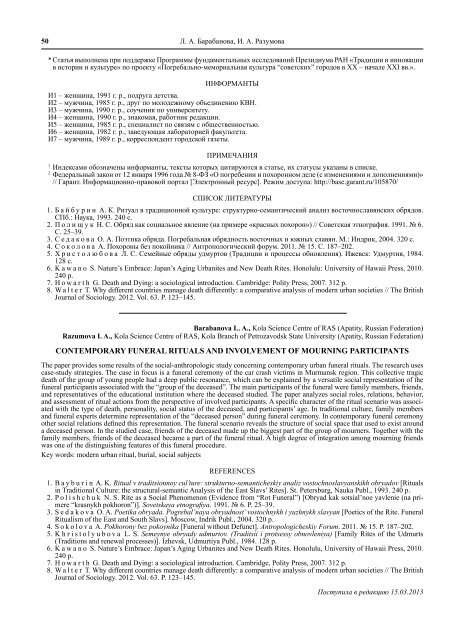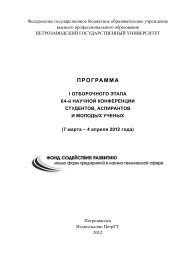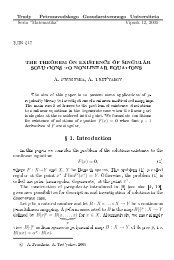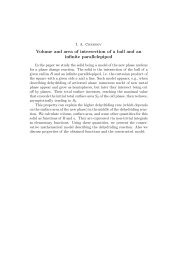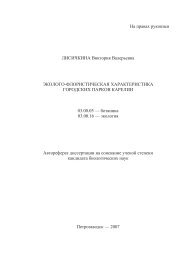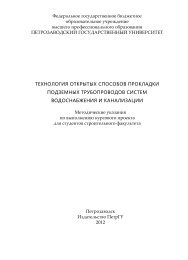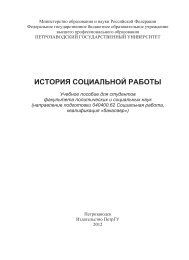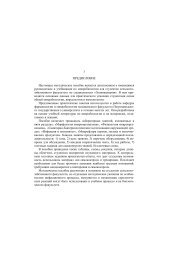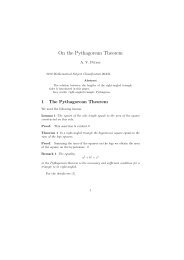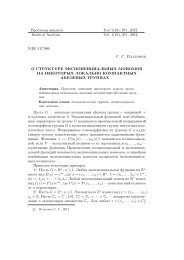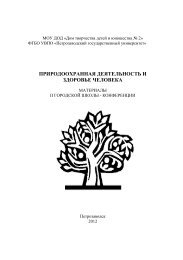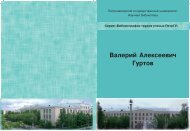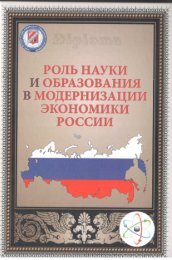5 (134). ÐвгÑÑÑ - УÑенÑе запиÑки ÐеÑÑозаводÑкого ...
5 (134). ÐвгÑÑÑ - УÑенÑе запиÑки ÐеÑÑозаводÑкого ...
5 (134). ÐвгÑÑÑ - УÑенÑе запиÑки ÐеÑÑозаводÑкого ...
Create successful ePaper yourself
Turn your PDF publications into a flip-book with our unique Google optimized e-Paper software.
50<br />
Л. А. Барабанова, И. А. Разумова<br />
* Статья выполнена при поддержке Программы фундаментальных исследований Президиума РАН «Традиции и инновации<br />
в истории и культуре» по проекту «Погребально-мемориальная культура “советских” городов в XX – начале XXI вв.».<br />
ИНФОРМАНТЫ<br />
И1 – женщина, 1991 г. р., подруга детства.<br />
И2 – мужчина, 1985 г. р., друг по молодежному объединению КВН.<br />
И3 – мужчина, 1990 г. р., соученик по университету.<br />
И4 – женщина, 1990 г. р., знакомая, работник редакции.<br />
И5 – женщина, 1985 г. р., специалист по связям с общественностью.<br />
И6 – женщина, 1982 г. р., заведующая лабораторией факультета.<br />
И7 – мужчина, 1989 г. р., корреспондент городской газеты.<br />
ПРИМЕЧАНИЯ<br />
1<br />
Индексами обозначены информанты, тексты которых цитируются в статье, их статусы указаны в списке.<br />
2<br />
Федеральный закон от 12 января 1996 года № 8-ФЗ «О погребении и похоронном деле (с изменениями и дополнениями)»<br />
// Гарант. Информационно-правовой портал [Электронный ресурс]. Режим доступа: http://base.garant.ru/105870/<br />
СПИСОК ЛИТЕРАТУРЫ<br />
1. Байбурин А. К. Ритуал в традиционной культуре: структурно-семантический анализ восточнославянских обрядов.<br />
СПб.: Наука, 1993. 240 с.<br />
2. Полищук Н. С. Обряд как социальное явление (на примере «красных похорон») // Советская этнография. 1991. № 6.<br />
С. 25–39.<br />
3. Седакова О. А. Поэтика обряда. Погребальная обрядность восточных и южных славян. М.: Индрик, 2004. 320 с.<br />
4. Соколова А. Похороны без покойника // Антропологический форум. 2011. № 15. С. 187–202.<br />
5. Христолюбова Л. С. Семейные обряды удмуртов (Традиции и процессы обновления). Ижевск: Удмуртия, 1984.<br />
128 с.<br />
6. K a w a n o S. Nature’s Embrace: Japan’s Aging Urbanites and New Death Rites. Honolulu: University of Hawaii Press, 2010.<br />
240 p.<br />
7. H o w a r t h G. Death and Dying: a sociological introduction. Cambridge: Polity Press, 2007. 312 p.<br />
8. W a l t e r T. Why different countries manage death differently: a comparative analysis of modern urban societies // The British<br />
Journal of Sociology. 2012. Vol. 63. P. 123–145.<br />
Barabanova L. A., Kola Science Centre of RAS (Apatity, Russian Federation)<br />
Razumova I. A., Kola Science Centre of RAS, Kola Branch of Petrozavodsk State University (Apatity, Russian Federation)<br />
CONTEMPORARY FUNERAL RITUALS AND INVOLVEMENT OF MOURNING PARTICIPANTS<br />
The paper provides some results of the social-anthropologic study concerning contemporary urban funeral rituals. The research uses<br />
case-study strategies. The case in focus is a funeral ceremony of the car crash victims in Murmansk region. This collective tragic<br />
death of the group of young people had a deep public resonance, which can be explained by a versatile social representation of the<br />
funeral participants associated with the “group of the deceased”. The main participants of the funeral were family members, friends,<br />
and representatives of the educational institution where the deceased studied. The paper analyzes social roles, relations, behavior,<br />
and assessment of ritual actions from the perspective of involved participants. A specific character of the ritual scenario was associated<br />
with the type of death, personality, social status of the deceased, and participants’ age. In traditional culture, family members<br />
and funeral experts determine representation of the “deceased person” during funeral ceremony. In contemporary funeral ceremony<br />
other social relations defined this representation. The funeral scenario reveals the structure of social space that used to exist around<br />
a deceased person. In the studied case, friends of the deceased made up the biggest part of the group of mourners. Together with the<br />
family members, friends of the deceased became a part of the funeral ritual. A high degree of integration among mourning friends<br />
was one of the distinguishing features of this funeral procedure.<br />
Key words: modern urban ritual, burial, social subjects<br />
REFERENCES<br />
1. B a y b u r i n A. K. Ritual v traditsionnoy cul’ture: strukturno-semanticheskiy analiz vostochnoslavyanskikh obryadov [Rituals<br />
in Traditional Culture: the structural-semantic Analysis of the East Slavs’ Rites]. St. Petersburg, Nauka Publ., 1993. 240 p.<br />
2. P o l i s h c h u k N. S. Rite as a Social Phenomenon (Evidence from “Rot Funeral”) [Obryad kak sotsial’noe yavlenie (na primere<br />
“krasnykh pokhoron”)]. Sovetskaya etnografi ya. 1991. № 6. P. 25–39.<br />
3. S e d a k o v a O. A. Poetika obryada. Pogrebal’naya obryadnost’ vostochnykh i yuzhnykh slavyan [Poetics of the Rite. Funeral<br />
Ritualism of the East and South Slavs]. Moscow, Indrik Publ., 2004. 320 p.<br />
4. S o k o l o v a A. Pokhorony bez pokoynika [Funeral without Defunct]. Antropologicheskiy Forum. 2011. № 15. P. 187–202.<br />
5. K h r i s t o l y u b o v a L. S. Semeynye obryady udmurtov. (Traditsii i protsessy obnovleniya) [Family Rites of the Udmurts<br />
(Traditions and renewal processes)]. Izhevsk, Udmurtiya Publ., 1984. 128 p.<br />
6. K a w a n o S. Nature’s Embrace: Japan’s Aging Urbanites and New Death Rites. Honolulu, University of Hawaii Press, 2010.<br />
240 p.<br />
7. H o w a r t h G. Death and Dying: a sociological introduction. Cambridge, Polity Press, 2007. 312 p.<br />
8. W a l t e r T. Why different countries manage death differently: a comparative analysis of modern urban societies // The British<br />
Journal of Sociology. 2012. Vol. 63. P. 123–145.<br />
Поступила в редакцию 15.03.2013


